Emergency Radiation Medicines
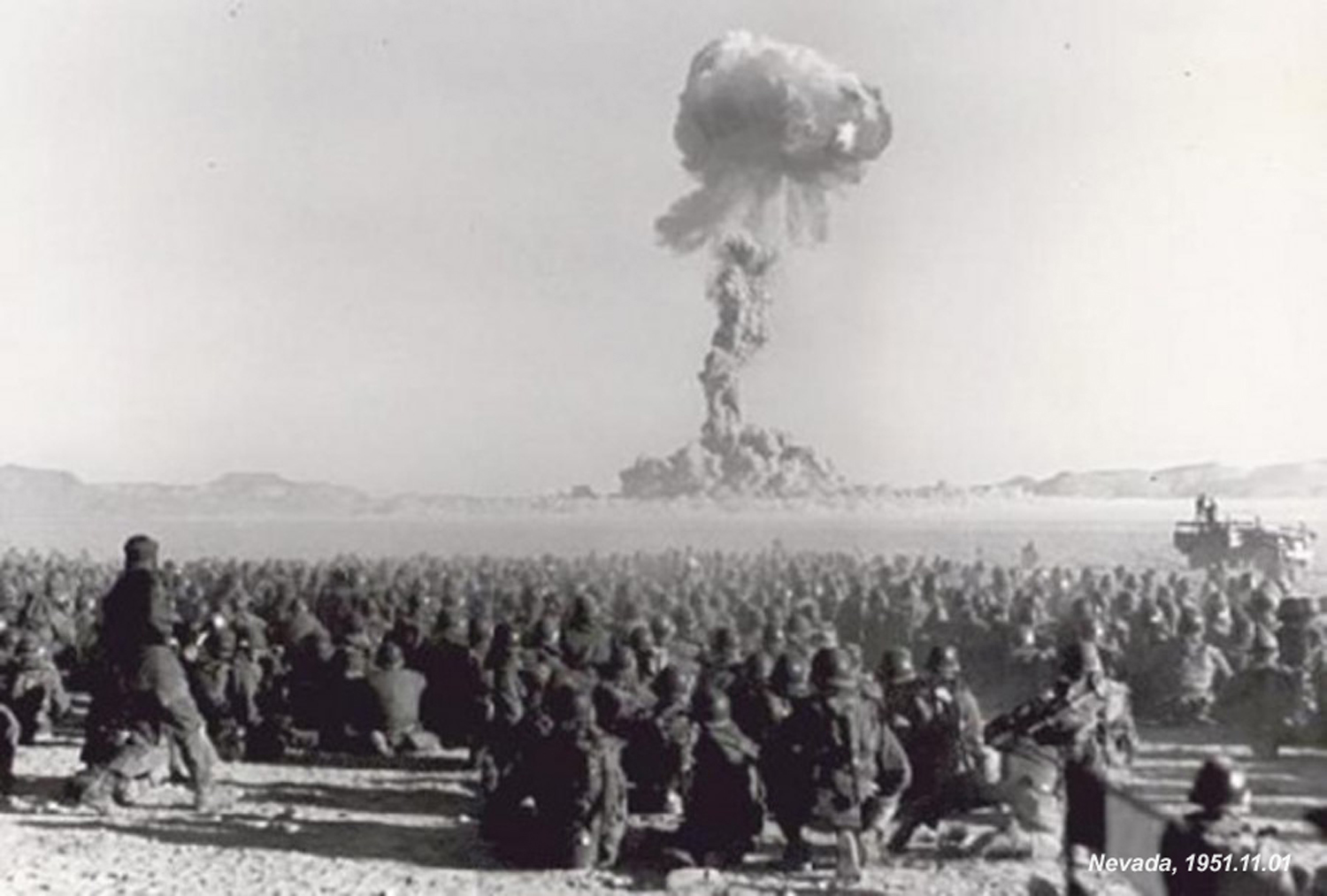
American exercises "Desert Rock" with the use of nuclear weapons. 1951
Despite the fact that a person has always lived in conditions of natural radiation, from the middle of the last century he had a new radiation threat of anthropogenic radiation in emergency situations. This may be the situation of the use of atomic weapons, an accident at a nuclear facility or an act of terrorism using a dirty bomb.
In the event of such a serious threat, the population is most effectively saved by evacuation, although a number of medications can be applied to them. But the rescuers and the military, who will have to work in dangerous conditions, must necessarily be supplied with personal protective equipment, including various medicines from the effects of ionizing radiation. I will try to describe a number of such drugs, called radioprotectors, and scenarios for their use in this article.
What is radiation
Before we talk about pills from radiation, let's determine what radiation is and how to protect oneself from it. This is useful in further explaining the principle of operation of certain drugs.
')
The common word radiation in household use can be understood as several types of radiation - alpha, beta, gamma, neutron and X-rays, and sources of these radiation in the form of radioactive substances - radionuclides, that is, radioactive isotopes of chemical elements. If we talk about protection from radiation in emergency situations, then it should be understood as a set of measures to reduce both the effects on the body of radiation and the prevention of contact with radionuclides and their accumulation in the body.
If these radionuclides are inside the body, then the person is exposed to internal radiation. If radionuclides and other sources of radiation are outside, then external.
I think it is no secret to anyone that radiation appeared not with the development of atomic energy or with the advent of atomic weapons, but always in nature. It is just that the activity of a man who built accelerators and atomic reactors led to the appearance of new radioactive isotopes, such as plutonium-239 or cesium-137, which are either long away from nature or too few in nature.
But besides them, our body constantly contains natural radionuclides such as potassium-40, we breathe radioactive gas with radon released from the ground, outside we are irradiated by cosmic radiation and the background from radionuclides on the surface of the earth. those. there is a certain natural radioactive background, which is considered normal, from which it is worth defending only in the case of its abnormal increase (for example, from high radon concentrations in homes).
It should immediately be recalled that in addition to the drugs to which this article is devoted, three classical methods of protection against radiation — time, distance, and substance — are much more common. This means that you should try to reduce the time of presence in the zone of high radiation, stay away from them and, if possible, close the radiation sources with shields of various substances such as lead, steel, concrete, water, paraffin and many others, depending on the type of radiation .
The effects of radiation on the body
Radioactive radiation is called ionizing, because from other types of radiation, such as radio waves or any other electromagnetic radiation, they are characterized by high energy and the ability to ionize a substance - to detach electrons from atoms, forming ions. The free electrons and ions formed inside the organic compounds trigger a complex chain of chemical reactions, resulting in the breaking of complex protein molecules and the formation of very active forms of free radicals. In the water, which constitutes 80% of the human body, its own ionization products are formed - strong oxidizing agents in the form of hydrogen peroxide and hydroperoxide. All these free radicals then interact with organic molecules, including DNA (hence the increased likelihood of cancer and genetic disorders in the offspring after irradiation), disrupting the normal functioning of body cells or completely destroying them.

A simple infographic on the effects of radiation on the body. RIA News, Infographics. Nadezhda Andrianova
In the most extreme case, such cell damage can lead to severe intoxication of the body, damage to the most sensitive tissues, such as bone marrow, and death of the whole body from acute radiation sickness. If you receive sufficiently high doses (more than 10 Sv), you can die on the spot - this is the so-called “death under the beam”. With small doses, the body can completely cope with injuries, but the likelihood of cancer or genetic consequences in the offspring increases with increasing dose, although they do not necessarily appear. Since the protective properties of the body can fight cell damage and cut off unnecessary mutations, but the more damage there is, the higher the chance that something the body will miss.
Radiation preparations
As we understood above, the method of radiation exposure on the body itself is very difficult, not fully understood, and takes place in several physical and chemical stages. Existing methods of chemical protection also differ depending on how they interfere with the processes described above to cause harm to the body. Thus, emergency radioprotectors can be divided into two types:
1. Drugs that protect the body from acute radiation damage.
2. Preparations preventing the accumulation of radionuclides or removing them from the body.
Type 1. Preparations protecting the body from acute radiation damage
The scenario of using such means assumes that a person knows in advance that he will have high exposure and takes them a few minutes or hours before or immediately after exposure. Take them a few hours after irradiation is already useless.
Such scenarios are relevant for the military during any operation during a nuclear war, for special forces, rescuers, employees of nuclear facilities in case of the need to eliminate some kind of emergency well and for providing emergency assistance to victims of these accidents. It is clear that these are all extreme scenarios, when there is a certain task that needs to be performed at almost any cost and other protection options cannot give the desired effect. In the case of such a threat, it is easier and more correct for the population and ordinary people to just evacuate.
Many radioprotectors are able to reduce the formation of free radicals, to destroy or prevent their formation in the cell. Others are able to reduce the access of oxygen from the blood to the cell (for example, vasoconstrictors), and thereby reduce the level of reactive oxygen species that increase the damaging effects of active radicals. Still others can control the accumulation of peroxide products in the cell - a number of enzymes (catalase, peroxidase, cytochrome c-450) and antioxidants (thiol, biogenic amines).
However, the effectiveness of these drugs is quite low, few people have come down to use in humans, and they have many side effects. In experiments on the study of the drug MEA with mice, it was possible to increase the half-lethal dose (after receiving which half of the mice die within 30 days) by 1.5-2 times, but with increasing drug concentration, the mice started to die from it. So everything is not easy.
Here are some well-known drugs: cystamine, mercamine, cystamine, MEA, AET, gammaphos, WR 2721, serotonin, 5-OT, mexamine, 5-ILO.
In the Soviet first aid kit in case of emergencies, the AI-2 (used from 1978 to 2000s) one of two (about the second just below) anti-radiation agents was Cystamine , a radioprotective agent No. 1. According to the website of the Ministry of Defense, it weakens the effect of training by 1.3 - 1.5 times. According to the instructions you need to immediately take 6 tablets of 0.2 g for 30-60 minutes before irradiation. If you save the threat - repeat the reception no earlier than in 4-5 hours.
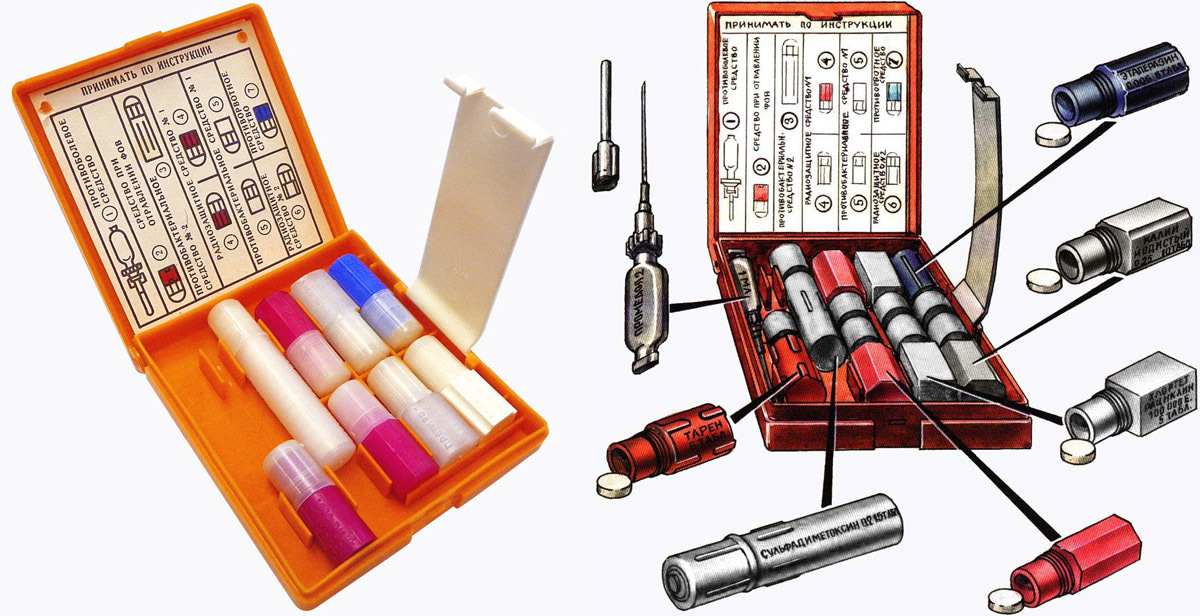
First aid kit AI-2. (From 1978 to 2012). Slot 4: Radioprotective # 1 - Cystamine . Nest 6: Radioprotective agent number 2 - Potassium iodide. Nest 7: Antiemetic - Seperatezin
Currently, a more modern emergency medicine B-190 (indralin) is present in the personal protection kits of the Ministry of Emergency Situations , the Ministry of Defense, and the AI-4 civilian first-aid kits that replaced the AI-2.
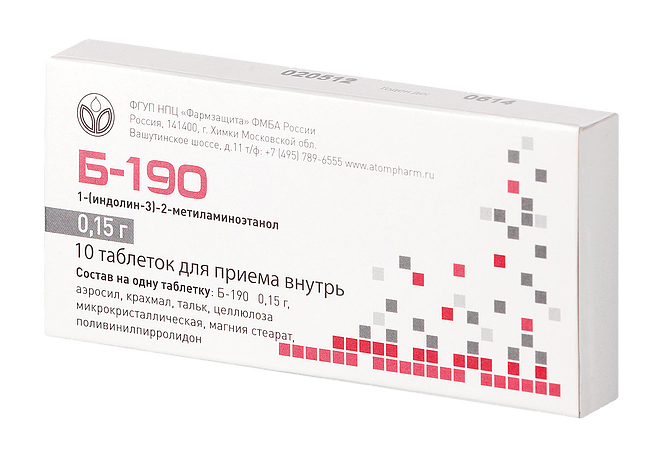
The drug B-190 in the original packaging.
According to the manufacturers of the Federal State Unitary Enterprise Scientific and Production Center “Farmzashchita” B-190 is able to ensure survival in 90% of cases when a lethal dose is received. And the indication for use - the projected dose of the whole body is more than 1 Sv (the lower limit of the onset of acute radiation sickness). Apply as Cistamine and immediately on 3 tablets within an hour before irradiation.
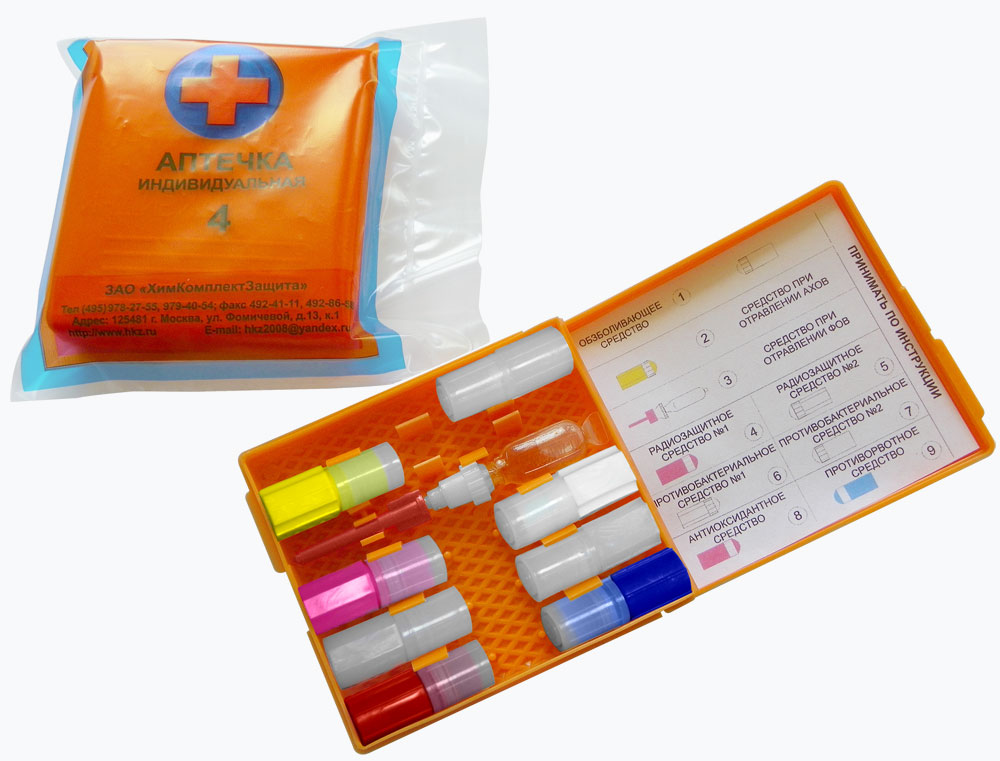
First aid kit AI-4. (Adopted since 2012). Slot 4: Radioprotective agent No. 1 - B-190 . Slot 5: Radioprotective Agent No. 2 - Potassium Iodide. Nest 9: Antiemetic - Ondansetron
For reference, the liquidators of the Chernobyl accident in 1986 set a limit on the received dose of 0.25 Sv (25 Roentgen or 25 rem - if we take it in units adopted at that time). About 100,000 military liquidators received an average dose of 0.11 Sv. There is a number of evidence of the use of cystamine by pilots of helicopters flying over the reactor. But I did not find information on the use of drugs by those who worked in the “hottest” place - on the roof of the neighboring block, dropping back what flew out of the core.
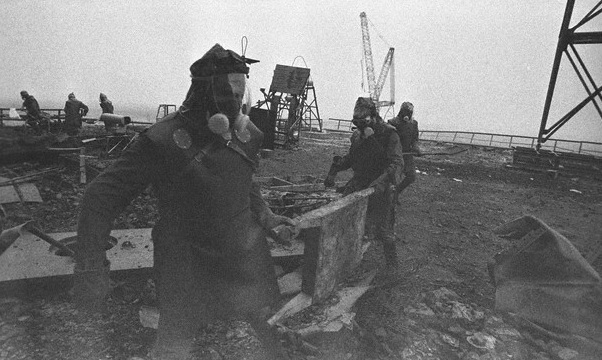
Liquidators on the roof of the Chernobyl NPP emergency unit are dumping back debris from the fuel and the active zone into the reactor shaft. Autumn 1986.
But there they tried to regulate the dose in the classical way - by limiting the time of presence (several minutes) and physical protection - with lead aprons, well, with gas masks or respirators to prevent internal exposure. It is difficult to say how adequate the measures were, there is a lot of evidence of a rather careless attitude towards dose control and individual defense. But out of several hundred people who had suspected acute radiation sickness, it was confirmed only in 134 people. Of these, 28 died, who received doses from 0.8 to 16 Sv.

Killed among those who received acute radiation sickness in the Chernobyl accident zone, according to A.K. Guskova, the legendary doctor who laid the foundation for the treatment of radiation sickness in our country long before Chernobyl and treated the injured in 1986. Taken from her article "The consequences for the health of persons involved in the elimination of accidents at the Chernobyl nuclear power plant, the main results and unsolved problems"
So even among the hundreds of thousands of liquidators of the dose, at whom the use of the preparation B-190 was recommended (more than 1 Sv for several hours), only tens of people received. Perhaps he would have saved their lives.
In both first-aid kits, AI-2 and AI-4, antiemetic drugs are present - Eperatezin and Ondansetron (He is also Latran ). They can also be attributed to radiation protection, as one of the first symptoms of overexposure and acute radiation sickness is vomiting and nausea. These drugs can relieve symptoms and maintain partial performance under high exposure. Other similar drugs: Dimetpramid, Dinitrol, Zofram, Dixafen.
Type 2. Preparations preventing the accumulation of radionuclides and removing them from the body
The danger of facing a radiation threat in the form of radionuclides is a much more typical scenario for a simple man in the street and the public in the case of radiation accidents and even more so in the case of a hypothetical terrorist attack using a dirty bomb . For the latter, it is the sprayed radionuclides that are the main damaging element, well, except for panic. The fact that a dirty bomb can be dangerous can be found in the quite good National Geographic documentary, where a hypothetical scenario of its use in a large city is considered:
During the Chernobyl disaster, the population was also mainly exposed to radiation due to the ingested radionuclides, while acute radiation damage was observed in only a few hundred liquidators .
But there is good news. In the field of creating radioprotectors of the second type from the most dangerous radionuclides for humans - I-131 (Iodine-131) and Cs-137 (Cesium-137), much better results were achieved than with radioprotectors of the first type. At least with the right dosages and timely use, they have almost no side effects, and the efficiency can reach almost 100%.
Both I-131 and Cs-137 are decay products of uranium and are formed in nuclear reactors during their operation. In the event of an accident, they can go beyond the reactor in the form of a gas-aerosol release, as was the case at Chernobyl and Fukushima. Their difference is that Iodine-131 is released in a volatile form and has a short half-life - only about 8 days. Therefore, the threat from it is possible only in the event of an accident at an operating nuclear reactor (at a nuclear power plant, atomic icebreaker, research reactor, etc.) and only in the first few days and weeks after the accident. But this is perhaps the main threat to the public in the event of an accident at a nuclear power plant. According to the UN report , the only reported radiation-induced harm to the health of the population from the Chernobyl accident is 4,000 cases of detected thyroid cancer in children and adolescents at the time of the accident. The vast majority (99%) of them survived.
From iodine-131 can be protected by the well-known iodine prophylaxis. Iodine tends to accumulate unevenly in the body, about a third of its intake accumulates in the thyroid gland, putting it at greatest risk, increasing the likelihood of cancer. Iodine prophylaxis is to saturate the body with stable iodine, with the result that its radioactive isotopes are simply displaced and not absorbed. Thus, this is somewhat similar to the protection against radiation by distance and time at the same time, since radiation sources are removed from the body and their presence in it is greatly reduced.
The main problem here is not to overdo it. Since iodine is widely available, just as radiophobia is widespread, any news about a state of emergency at a nuclear power plant can cause a panic wave among the population, followed by buying up all the iodine from pharmacies and even poisoning. The correct dosages and preparations are described in detail here . It is best to use potassium iodide tablets. The rate for an adult is one tablet of 125 mg per day. In extreme cases, you can use a 5% alcoholic solution of iodine, dissolving 1 ml (44 drops) in half a glass of milk or water.
In cesium, the half-life is much longer - about 30 years. Therefore, it will pose a threat much longer - still large areas are contaminated with cesium after the Chernobyl accident, historical and forecast levels can be found in the Atlas compiled on the website of the Ministry of Emergency Situations.
A similar release was at the Fukushima nuclear power plant. The long half-life of cesium-137 also determines that its release is possible not only in the event of an accident at a nuclear power plant reactor, where this cesium is formed, but also in case of accidents at other nuclear facilities, where it is stored, for example, at plants for the reprocessing of spent nuclear fuel. . Such an accident was at Mayak in the Chelyabinsk region in 1957, where a container with radioactive waste exploded, which led to the formation of the East-Ural radioactive wake. It is cesium that can most likely be used in a dirty bomb, as shown in the National Geographic movie above.
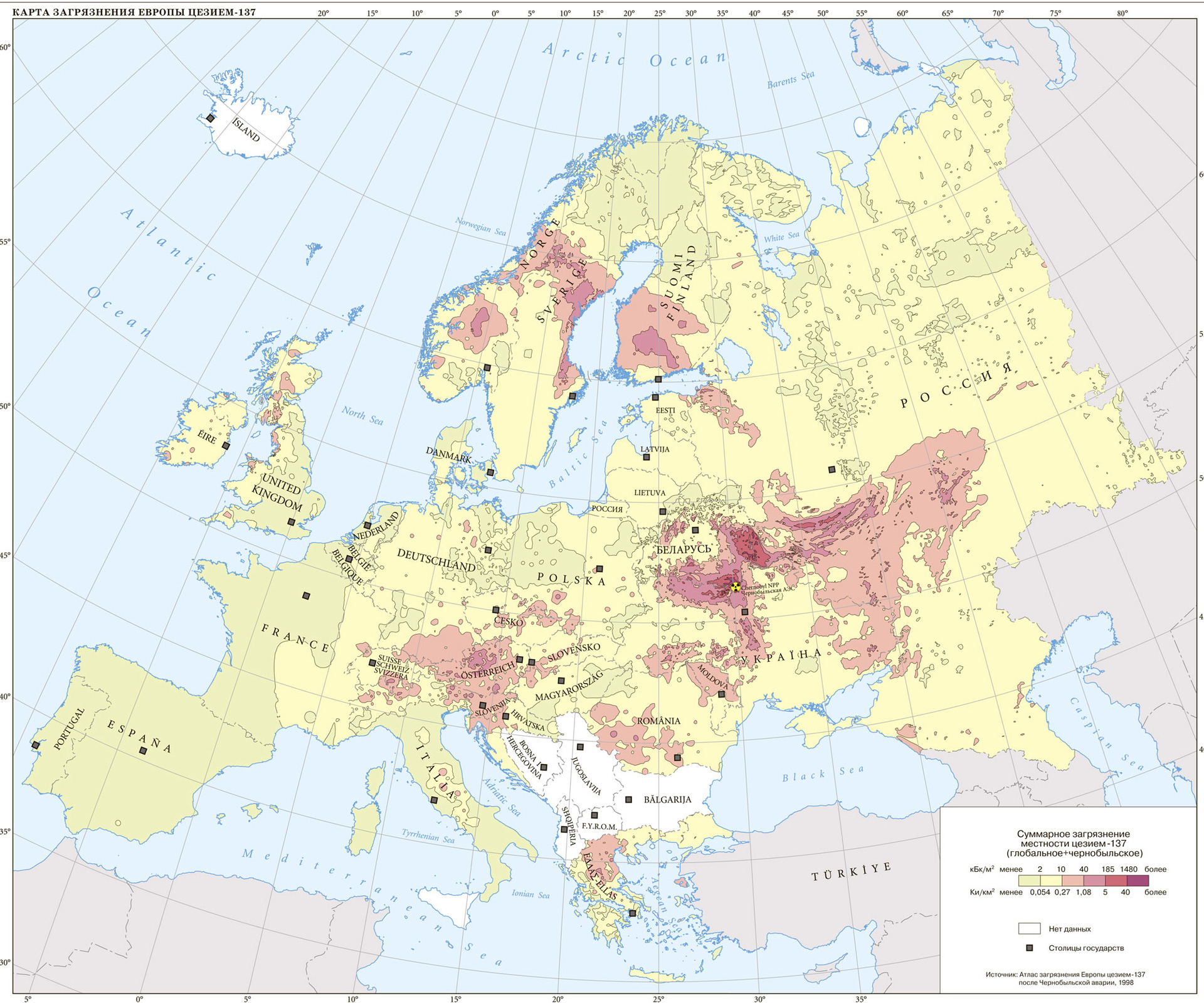
Map of European contamination with cesium-137 from the accident at the Chernobyl nuclear power plant for 1986. Data of the Emergency Ministry of the Russian Federation .
But for removing cesium-137 there is also a good preparation known in the world as the Berlin blue. Although in fact it is the name of a fairly wide class of compounds that have historically been used as dyes, and far from all of them absorb Cs-137 well. In the film National Geographic about this preparation under the general name of the Berlin blue tell from the 25th minute. In the USSR and Russia, the sorbent for the extraction of Cs-137 on the basis of this class of compounds (ferrocyanides) and the medical drug for humans is called Ferrotsin . The principle of its operation is simple - it binds (absorbs) cesium, which has been supplied with food and water inside the gastrointestinal tract and does not allow it to be absorbed into the blood and enter the body. As a result, up to 99% of incoming cesium passes through the gastrointestinal tract without being directly delayed.
Ferrotsin tablets are released more than once mentioned FSUE NPT "Pharmzashchita". Of the foreign analogues of ferocin-containing preparations, there is Radiogardase made in Germany. Of the other domestic ones, the new drug Compoferron , although in addition to removing Cs-137 and thallium, as a drug with a high iron content, it is more aimed at treating anemia.
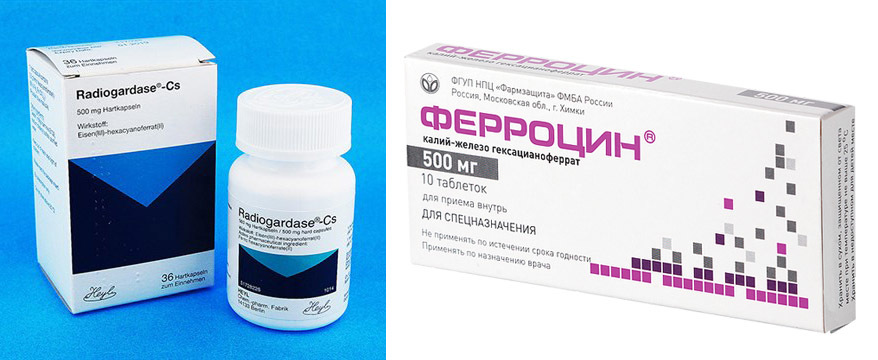
Ferrotsinsoderzhaschie drugs for removing cesium from the body. Foreign Radiogardase and domestic Ferrotsin .
In case of a radiation accident, the Federal Center for Disaster Medicine “Protection” of the Ministry of Health recommends using Ferrotsin “1 g (2 tablets) 3 times a day in case of a threat or actual ingestion of radioisotopes of cesium, rubidium and other fission products of transuranium elements and also in the case of the impossibility of excluding the receipt of radioactive cesium in the gastrointestinal tract with water or food . "
What does the last mean? This applies to the situation when people continue to live and manage households in territories contaminated with radionuclides. Such territories after the Chernobyl accident is full. In Russia, the Bryansk, Tula, Oryol and Kaluga regions turned out to be the most polluted (here you can take another look at the Ministry of Emergency Situations Atlas , where there are all pollution maps. There are such territories in Ukraine, Belarus, Europe and the Semipalatinsk test site in Kazakhstan , and since 2011 in Japan.
According to the UN , at least 5 million people now live in areas contaminated with radionuclides after the Chernobyl accident. There are many arguments in favor of trying to return these territories to normal and habitual use. You don’t evacuate everyone, people don’t want to leave themselves, and there is no particularly urgent need, because pollution levels sometimes do not require evacuation - the external background is low, the concentrations of radionuclides are low. But certain levels of pollution impose restrictions on the use of locally produced agricultural products, since radionuclides are concentrated in it, and on its sale to other regions. The use of ferrocin-containing drugs allows you to remove this restriction. Roughly speaking, you can eat cucumbers and tomatoes grown in a garden with a small content of cesium, or you can drink milk and eat cow meat grazing in meadows with cesium, if you eat it all with ferrocin tablets.
But it is possible to go further, if, for example, to give the same ferrocin to the cow, pig or chicken. Will meat and milk be cleaner? After Chernobyl, such experiments were carried out and the answer is unequivocal - yes. On the basis of pure Ferrotsin, a number of preparations have been created for convenient use on animals, including pure ferrocin powder, lichens with ferrocin, or the preparation Bifezh , where the content of ferrocin is about 10%. With the right dosage (from 3 g in terms of ferrocin per head per day), these drugs can reduce the content of cesium and heavy metals in milk and meat of cows by 10-20 times. So with such radioprotectors it is possible not only to consume products from these territories independently, but also to return them to economic circulation, growing these products for sale, since they already fit into the established standards for the content of radionuclides.
Of the drugs for people it is worth mentioning at least two more. This is the Polysurmin - for the elimination of strontium isotopes - first of all, strontium-90, which has a close half-life (slightly less than 30 years) with cesium -137 and a fraction of the yield from nuclear fission, i.e. its amount in the reactor. These two factors explain why, in addition to pollution maps from the Chernobyl accident, there are similar maps of strontium pollution.
It is also worth mentioning the drug Pentacin , which speeds up the excretion of plutonium, yttrium, cerium, zinc, cadmium, cobalt, manganese and lead, including their radioactive isotopes.
Conclusion
If you are not a military man, not a rescuer or an employee of a nuclear facility, then you should not be afraid of acute external exposure as a result of any incident. Even among the liquidators of the Chernobyl accident only a very small proportion of people found themselves in situations in which the use of the first type of radioprotectors is advisable. Not surprisingly, they are present only in special pts. But knowing how to defend oneself from a possible release of radionuclides will not be superfluous, since this is the main threat to the public in the event of radiation accidents and terrorist attacks. It is useful to be able to do iodine prophylaxis safely and in a timely manner, since everyone has access to iodine. And then, unknowingly, there will be a wave of poisoning, as it was in 2004 after the incident at the Balakovo NPP .
Ferrotsinsoderzhaschie drugs included in the list of compulsory drugs of the US national storage Strategic National Stockpile , the reserves of which can be used to rescue the population in case of emergencies or terrorist attacks. In Russia, such drugs, radioprotectors, along with the fact that they are in AI-4, are included in the extended list of drugs , the stocks of which must be created for 100% of the personnel of the Emergencies Ministry and the Ministry of Defense. But it is not known whether there is such a reserve for the population in case of a large-scale radiation emergency.
References and sources:
1. Order EMERCOM of Russia of January 23, 2014 No. 23, On the Acceptance of the Individual Medical Civil Protection Kit (KIMPP) for the supply of the Emergencies Ministry of Russia
2. A.K.Guskova, V.I. Krasnyuk. Implications for the health of persons involved in the liquidation of accidents at the Chernobyl nuclear power plant, the main results and unsolved problems // Occupational Medicine and Industrial Ecology. - 2012. - № 10. - .11-19. –ISSN 1026-9428.
3. Ecological consequences of the Chernobyl accident and their elimination: twenty years of experience // Report of the Ecology expert group of the Chernobyl Forum, International Atomic Energy Agency, Vienna, 2006 - ISBN 978–92–0–409307–0.
4. Clinical guidelines for the provision of medical care to victims of ionizing radiation in emergency situations. All-Russian Center for Disaster Medicine "Protection" of the Ministry of Health of the Russian Federation
5. Order N 633 of the Ministry of Emergency Situations of Russia of November 1, 2006 ON ACCEPTANCE FOR THE EMERCOM OF RUSSIA EMPLOYMENT
6. Chernobyl: the true scale of the accident. Joint press release WHO / IAEA / UNDP
7. Chemical protection against radiation damage. Yu. B. Kudryashov. Moscow State University Mv Lomonosov.
Source: https://habr.com/ru/post/397639/
All Articles